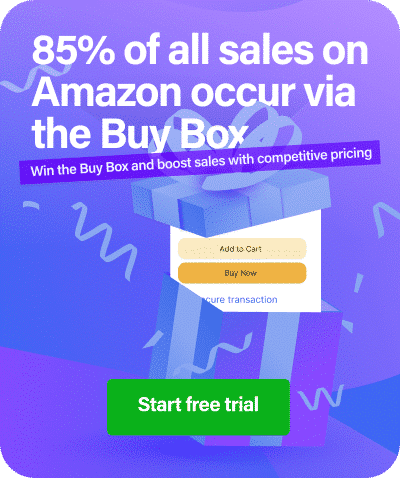Competitor analysis is an essential practice for any Amazon seller navigating the highly competitive e-commerce landscape. In a marketplace as vast and dynamic as Amazon, with millions of sellers vying for the attention of over 300 million active customers, understanding competitors’ strengths, weaknesses, strategies, and performance is not just advisable; it’s imperative.
Why Conduct Competitor Analysis?
You might wonder why you need to dive into the intricacies of competitor analysis while running your Amazon business. After all, you have enough on your plate figuring out customer needs, managing inventories or enhancing sales strategies. Now am I suggesting that you shift focus from inward observation to outward examination? You bet!
To begin with, think of competitor analysis as an exploration expedition rather than a distraction. As Marketer Mike Gospe put it concisely “Whoever understands the customer best, wins”. It’s about discerning patterns in the marketplace and recognizing which can give you a strategic advantage.
This careful investigation offers valuable insight into trends, product preferences, and market gaps that were previously overlooked. By learning from others’ successes and mistakes, you could create fundamental adjustments that fire up your success trajectory.
Moreover, conducting an amazon competition analysis helps identify top-selling products and evaluate effective marketing techniques employed by industry leaders; making it easier for you to replicate their triumphs selectively while sidestepping pitfalls they may have stumbled upon.
Furthermore, carrying out an equal footing comparison with competitors—be it product variety, quality, pricing strategy or customer service approach— equips you with actionable data to make informed decisions regarding varying elements of your business operation; thus creating a unique market propositioned anchored in reality yet enticingly different.
Lastly but critically important, periodic competitor analyses keep you up-to-date with marketplace dynamics—an ever changing landscape no doubt—and upcoming disruptions thereby allowing adequate adjustment time window for taking preemptive actions.
7 Powerful Steps to Amazon Seller Competitor Analysis
To whoop your competitors on Amazon, you need to know what they’re up to. The following outline provides a comprehensive approach for conducting an Amazon seller competitor analysis:
Step 1: Identify Your Competitors

Start by defining who your rivals are.
First, research keywords. Start broad, searching terms related to your product. Then, refine your search with long-tail keywords to identify the sellers consistently ranking at the top. These are likely your main competitors. Imagine you sell handmade woolen hats for women. Start by searching “winter hat” on Amazon. The competition will be fierce for such a broad term.
Refine your search with “cashmere beanie for women.” Now you’ll see the sellers consistently ranking at the top.
Look at the top performers for your chosen keywords – they’re vying for the same customers as you. But remember, the competition landscape isn’t always black and white. Consider sellers offering substitutes or targeting a slightly different audience – they can still affect your sales.
Step 2: Analyze their Product Listings
Once you’ve identified your key competitors on Amazon, it’s time to delve deeper and analyze their product listings. This intel will be crucial for crafting your own winning strategy.
Start by scrutinizing their product descriptions. What tone of voice do they use? Do they focus on technical specifications or leverage emotional storytelling? Unearth the benefits they highlight and the features they prioritize. This will show you what resonates with your target audience and what aspects your competitors might be overlooking.
Shift your focus to the bullet points. These are prime real estate for grabbing attention. Analyze what information they convey and how effectively they showcase the product’s value proposition. Are they clear, concise, and benefit-oriented? You might discover opportunities to craft even more compelling bullet points for your own listing.
Finally, don’t underestimate the power of product photography. Look at the number and quality of the images used. Do they showcase the product from multiple angles? Do they feature lifestyle imagery that demonstrates the product in use? High-quality photos are essential for building trust and increasing conversions. By dissecting your competitors’ photo strategy, you can elevate your own product presentation and visually entice potential customers.
Step 3: Competitive Analysis of their Targeted Keywords

Unveiling your competitors’ secret weapon: their keyword strategy. After dissecting their listings, it’s time to crack the code of their targeted search terms. These are the keywords they’re using to optimize their listings and rank higher in Amazon’s search results. By understanding these terms, you can gain valuable insight into how your competitors attract customers.
There are a few ways to approach this. One method is to analyze customer reviews. Pay attention to the words and phrases customers use to describe the product, its features, and benefits. These can be goldmines for uncovering long-tail keywords that resonate with your target audience.
Another tactic is to leverage keyword research tools. Some tools offer a “reverse ASIN lookup” feature. By entering your competitor’s ASIN (Amazon Standard Identification Number), you can potentially uncover the keywords they’re ranking for.
Let’s revisit the handmade woolen hat example. Imagine you identified a competitor who consistently ranks high for “cashmere beanie for women.” By analyzing their reviews, you might discover customers raving about the hat’s “super soft feel” and its ability to keep them “warm and cozy all winter long.” These phrases translate into valuable long-tail keywords like “softest cashmere beanie for women” or “winter beanie for extreme warmth.”
By incorporating these competitor-discovered keywords into your own product listing and marketing efforts, you can increase your chances of capturing a wider audience and attracting potential customers who might have otherwise landed on your competitor’s page.
Step 4: Analyze Their Customer Reviews
Once you’ve unraveled your competitors’ keyword strategy, it’s time to tap into a treasure trove of customer insights: their review sections. Analyzing customer reviews is like eavesdropping on real conversations between your competitors’ customers. Here’s what you can learn:
- Customer Pain Points: Identify recurring themes in negative reviews. Are there features your competitors lack or areas where their products fall short? These are opportunities for your product to shine.
- Customer Preferences: Pay close attention to positive reviews. What aspects do customers love about the competing product? Are there specific features or benefits consistently praised? Understanding these preferences can help you tailor your own product offering and messaging.
- Sentiment Analysis: Look beyond the star ratings and delve into the sentiment of the reviews. Are customers frustrated, delighted, or indifferent? Identifying the overall emotional response can reveal areas for improvement across the board, not just in the product itself, but potentially in your customer service approach.
By analyzing customer reviews, you gain invaluable insights into what truly matters to your target audience. You can leverage this knowledge to refine your product development, optimize your listing content to address customer concerns, and potentially even develop a more customer-centric approach to your business.
Related: How to Get More Reviews on Amazon in 2024
Step 5: Competitive Analysis of their Marketing Strategy

You’ve analyzed their listings and keywords, now it’s time to understand how they’re actively reaching potential customers. One key area to explore is their advertising strategy on Amazon.
There are three main advertising options on Amazon: Sponsored Products, Sponsored Brands, and Display Ads. Sponsored Products are essentially pay-per-click (PPC) ads that display your product listing alongside search results. Sponsored Brands ads promote your entire brand or product line, and Display Ads reach customers across Amazon based on browsing behaviour and demographics.
By analyzing your competitors’ ad placements and the keywords they’re likely targeting, you can glean valuable insights. Unfortunately, you can’t directly see which specific keywords competitors are bidding on for Sponsored Products or Sponsored Brands ads. However, some tools can offer educated guesses based on factors like the product’s category and overall ad strategy.
Let’s revisit the woolen hat example. Imagine you discover your competitor running Sponsored Product Ads for their cashmere beanie. The ad might appear on searches for “winter hats for women” or “luxury beanies.” This indicates they’re targeting a broader audience interested in winter headwear. By analyzing their ad copy and the keywords they might be using, you can craft even more targeted Sponsored Product Ads for your own woolen hat. You could target long-tail keywords like “eco-friendly wool beanie for women” or “softest beanie for sensitive scalps,” attracting a more specific customer base seeking unique qualities your product offers.
Step 6: Analyze Their Pricing Strategy

Understanding your competitor’s strategy is crucial for setting your own competitive price. While price isn’t everything on Amazon, it’s a significant factor influencing buying decisions and helping to win the desired Buy Box. By analyzing your competitors’ pricing strategy, you can position your product for optimal sales and profitability.
There are a few key elements to consider. First, track your competitors’ prices over time. Are they constantly adjusting prices in response to market fluctuations or competitor actions? Do they frequently offer discounts or promotions? Identifying their pricing patterns will help you determine if they’re primarily focused on volume or maximizing profit margins.
Second, consider the value proposition of your product. Does your woolen hat boast unique features or superior quality compared to competitors’ offerings? If so, you might have more wiggle room to command a slightly higher price point.
However, manually monitoring competitor prices and adjusting your own accordingly can be a time-consuming task. This is where Amazon repricing tools come in. These tools automate the process of tracking competitor prices and adjusting your listings accordingly. By setting pre-defined pricing rules, you can ensure you stay competitive without sacrificing profitability.
Imagine you discover your competitor drops their cashmere beanie price by $5. With an Amazon repricer, you can set a rule to automatically adjust your woolen hat price by a certain percentage or fixed amount to stay competitive. This frees you up to focus on other areas of your business while ensuring you don’t miss out on sales due to pricing inconsistencies.
Step 7: Competitive Analysis of their Amazon Monthly Sales
While Amazon doesn’t provide public access to competitor sales data, there are ways to make educated guesses. Here’s where competitor analysis tools like Jungle Scout or AMZScout come in handy.
These platforms offer features that estimate a product’s monthly sales based on factors like Best Seller Rank (BSR) and historical sales data. By analyzing these estimates for your competitors’ products, you can gain valuable insights into their sales volume and potential market share.
Here’s how this can inform your decisions:
- Market Demand: High estimated sales figures for competitor products indicate strong market demand for the type of product you offer. This can motivate you to invest more resources into optimizing your listing and marketing efforts.
- Identify Opportunities: Conversely, if competitor sales estimates are lower than expected, it might suggest a gap in the market. You could use this insight to tailor your product offering or marketing message to a specific niche within the broader category.
- Refine Your Strategy: Understanding competitor sales estimates allows you to benchmark your own performance and set realistic sales goals. It can also help you determine the effectiveness of your current strategies and identify areas for improvement.
It’s important to remember that these sales estimates are not exact figures. However, by incorporating them into your competitor analysis, you gain valuable insights that can empower you to make informed decisions and develop a winning strategy for your Amazon business.
Ready to boost your Amazon sales? Sign up for Repricer’s 14-day free trial and discover the power of automated repricing.






